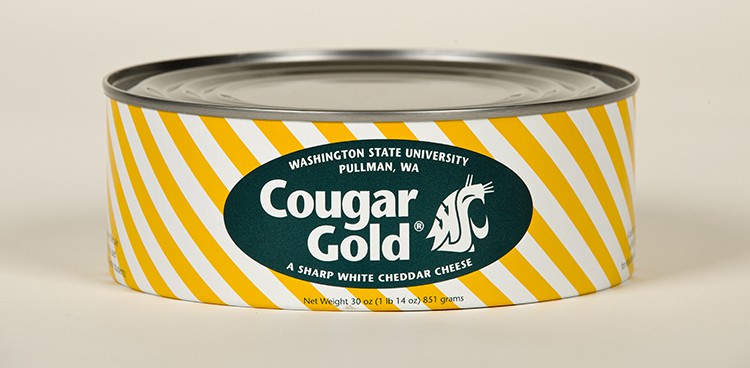
A Man, a Plan, a Can is featured in our Spring 2017 issue.
In today’s golden age of cheese, when consumers and industry alike revere quality ingredients and sustainable production, it might come as a surprise that one of the Pacific Northwest’s most beloved cheeses comes in a can: Washington State University Creamery Cougar Gold. Now, before you exclaim that it can’t possibly be as authentic and artisanal as your favorite Brie de Meaux, know this: The metal-clad round is a scientific wonder, tastes great, lasts forever, and has a 70-year-old history to boot.
It all started with N.S. Golding. An Englishman by birth, Golding got his first job at the milk factory that supplied Cadbury confectionary. A stint serving in World War I, several degrees in dairy science, and a couple of decades later, Golding became a professor at then-Washington State College in 1934. With World War II fast approaching, the US government was exploring new food storage technologies to supply its troops and, along with the American Can Company (a major player in the industry), it funded Golding’s research on canned cheese.
Canning cheese might seem like an odd choice, but at the time it was seen as a sure bet. Cheesemaking was invented to preserve milk beyond its usual shelf life, but less-than-ideal conditions during aging or transport—too dry, too moist, too hot, too cold—can quickly lead to spoilage. Dipping cheese in wax solved these issues, but if the wax cracked, the exposed cheese would rot. Plastic packaging was still over the horizon, so clean, modern cans were deemed the way to go.
The problem with cheese in cans, however, was that the metal containers were a little too good at protecting their contents. Cheese is a living food: Milk is inoculated with a starter culture of beneficial bacteria that converts lactose into lactic acid, jumpstarting flavor development and curd formation. Today’s equipment and sanitation practices are rigorous enough to keep most contaminants at bay, but back then it was all but inevitable that unwanted bacteria would make their way into a cheese, eat up nutrients and other bacteria, and emit carbon dioxide. This isn’t a problem if a wheel is aging in an open-air cave. But when a cheese is sealed in an airtight container, it can lead to unsightly bulges at best and exploding cans at worst.
Golding hit upon the idea of introducing a second culture specifically designed to limit carbon dioxide production to the mix. This adjunct culture, known as “WSU19,” solved the canned-cheese conundrum and altered the microbial environment enough to create an entirely new cheese—crumbly and nutty yet creamy on the palate, milky sweet with a gently dissipating sharpness. Current WSU Creamery manager John Haugen says tasters “compare it more to gouda or even parmesan, but [it’s] not that dry.”
In 1948, WSU Creamery released its first batch of Cougar Gold, named both for the WSU mascot and Golding. One catch: The cheese must be refrigerated, which—along with the arrival of cheaper plastic packaging—ultimately kept it from becoming the military’s super cheese. Still, as long as Cougar Gold is unopened and refrigerated, “it will last indefinitely,” according to the WSU Creamery website. (A couple recently brought a 37-year-old can to the dairy, and the cheese—sharper and more crumbly than the standard one-year wheel—packed a punch with plenty of tyrosine crystals.)
Not much has changed in almost 70 years since the first can of Cougar Gold was created. The wheel slimmed down from 4 pounds to 30 ounces once smaller can sizes became available, but WSU Creamery still uses the same yellow-and-white-striped packaging it did in the 1940s. The initial starter culture has been swapped for one that doesn’t generate carbon dioxide (to avoid production headaches), but young Cougar Gold is still inoculated a second time with WSU19 culture—a bit of which has been saved from every batch and kept alive, similar to how bakers maintain sourdough starter. As part of Washington State University, the financially independent creamery continues its commitment to education, with students largely manning the campus retail store and cheesemaking floor.
“It’s a great cheese and it is a great story that WSU students produce it,” Haugen says. WSU Creamery hasn’t rested on its gilded laurels, though—now it offers seven types of canned cheese in addition to Cougar Gold. Want to get your hands on some? While the cheese is only available at select retail locations in Washington State, shoppers may purchase it online (about 50 percent of the sales come through the WSU website).
The tinned cheese’s legacy transcends flavor and tradition—generations of cheesemakers have used skills learned there to better the cheese world. Alumni of WSU Creamery’s Cheesemaking Shortcourse work at Gothberg Farms, Twin Sisters Creamery, Mt. Townsend Creamery, Glendale Shepherd, and others. Beecher’s Handmade Cheese founder Kurt Dammeier (’82) makes his cheddar-style Flagship with a second culture in direct homage to Cougar Gold. And Haugen (’93) worked his way up from a student employee to the very top of the creamery.
So when it comes to Cougar Gold, don’t judge a cheese by its can. Give it a try. Or don’t—it can wait.
Feature Photo Courtesy of Washington State University



